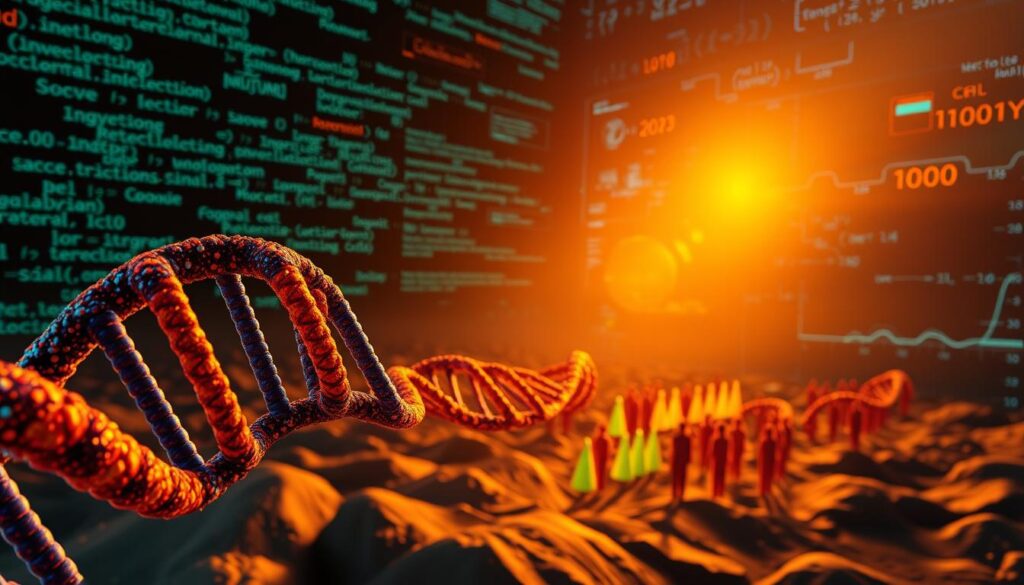Imagine being able to crack complex mathematical problems with ease, using a method inspired by nature’s own process of evolution. Genetic algorithms have revolutionized the way we approach complex math challenges, providing innovative solutions that were previously unimaginable.
Inspired by the principles of natural selection and genetics, these algorithms have been successfully applied to various mathematical problems, yielding impressive results. By harnessing the power of genetic algorithms in math, researchers and scientists can now tackle complex problems with greater accuracy and efficiency.
Key Takeaways
- Genetic algorithms are inspired by nature’s process of evolution.
- They provide innovative solutions to complex math challenges.
- Genetic algorithms have been successfully applied to various mathematical problems.
- They yield impressive results and improve accuracy and efficiency.
- Genetic algorithms are a powerful tool in mathematical problem-solving.
The Evolution-Inspired Approach to Problem Solving
Genetic algorithms have emerged as a powerful tool for solving complex mathematical problems, inspired by the principles of natural evolution. This approach to problem-solving is based on the concept of genetic algorithms optimization, where the fittest solutions are selected and used to create the next generation of solutions.
Darwin’s Theory in Computational Form
The idea of genetic algorithms is rooted in Darwin’s theory of evolution, which states that the fittest individuals are more likely to survive and reproduce. In computational terms, this translates to selecting the best solutions to a problem and using them to generate new solutions. This process is repeated until an optimal solution is found.
The Birth and Development of Genetic Algorithms
Genetic algorithms were first introduced in the 1970s by John Holland, who recognized the potential of evolutionary principles in computational problem-solving. Since then, they have been widely used to solve complex optimization problems in various fields, including mathematics.
Why Nature’s Optimization Strategy Works for Mathematics
Nature’s optimization strategy, as embodied in genetic algorithms, is effective for mathematical problems because it can handle complex, non-linear relationships between variables. The table below highlights some key benefits of using genetic algorithms for mathematical optimization.
| Benefit | Description |
|---|---|
| Handling Complexity | Genetic algorithms can tackle complex, non-linear problems with multiple variables. |
| Robustness | They are robust and can handle noisy or uncertain data. |
| Flexibility | Genetic algorithms can be adapted to various problem domains. |
By leveraging the principles of evolution, genetic algorithms provide a powerful tool for genetic algorithms problem solving in mathematics.
Understanding the Mechanics of Genetic Algorithms
To grasp how genetic algorithms work, it’s essential to understand their fundamental components and process flow. Genetic algorithms are a type of optimization technique that uses principles of natural selection and genetics to find the best solution among a set of possible solutions.
Key Components: Chromosomes, Genes, and Fitness Functions
The core elements of a genetic algorithm include chromosomes, which represent potential solutions, genes, which are the basic building blocks of chromosomes, and fitness functions, which evaluate the quality of each solution. The fitness function is crucial as it guides the algorithm towards the optimal solution.

The Genetic Algorithm Process Flow
The process flow of a genetic algorithm involves several key steps: selection, crossover, and mutation. These steps are iteratively applied to evolve better solutions over time.
Selection Methods: Tournament, Roulette Wheel, and Rank-Based
Selection is the process of choosing parents for the next generation. Common selection methods include tournament selection, where a subset of individuals is chosen based on their fitness, roulette wheel selection, where the probability of selection is proportional to fitness, and rank-based selection, which selects individuals based on their rank in the population.
Crossover Techniques: Single-Point, Multi-Point, and Uniform
Crossover involves combining the genetic information of two parents to create offspring. Techniques include single-point crossover, where a single crossover point is chosen, multi-point crossover, where multiple crossover points are selected, and uniform crossover, where genes are randomly selected from either parent.
Mutation Strategies and Rates
Mutation introduces random changes into the population to maintain genetic diversity. The mutation rate controls how often mutation occurs. A high mutation rate can prevent the algorithm from converging, while a low rate may lead to premature convergence.
Termination Criteria and Convergence
Genetic algorithms need termination criteria to stop the iteration. Common criteria include reaching a maximum number of generations or achieving a satisfactory fitness level. Understanding these mechanics is crucial for effectively applying genetic algorithms to complex mathematical problems, showcasing their genetic algorithms advantages in optimization tasks.
How Are Genetic Algorithms Used to Solve Complex Mathematical Problems?
By mimicking the process of natural evolution, genetic algorithms provide a unique approach to solving complex mathematical problems. This method has gained significant attention in recent years due to its ability to handle complex, nonlinear problems that are challenging for traditional optimization techniques.
Translating Mathematical Challenges into Genetic Algorithm Format
The first step in applying genetic algorithms to mathematical problems is to translate the challenge into a suitable format. This involves representing potential solutions as chromosomes, which are typically encoded as binary strings or vectors of real numbers. The encoding strategy depends on the nature of the problem and the desired representation of the solutions.
For instance, in optimization problems, the chromosome might represent a set of parameters that need to be optimized. The key is to ensure that the encoding allows for the effective application of genetic operators such as crossover and mutation.

Designing Effective Fitness Functions for Mathematical Optimization
The fitness function is a critical component of a genetic algorithm, as it determines the quality of the solutions. For mathematical optimization problems, the fitness function is typically derived directly from the objective function that needs to be optimized.
A well-designed fitness function should accurately reflect the problem’s objectives and constraints. It should also be able to differentiate between good and bad solutions, guiding the algorithm towards optimal or near-optimal solutions.
Constraint Handling Techniques in Mathematical Problems
Many mathematical problems involve constraints that must be satisfied. Genetic algorithms handle constraints through various techniques, including penalty functions, repair mechanisms, and the use of special encoding schemes that ensure feasibility.
Penalty functions, for example, penalize solutions that violate constraints, thereby guiding the search towards feasible regions of the solution space.
Encoding Strategies for Different Problem Types
The choice of encoding strategy is crucial for the success of a genetic algorithm. Different problem types require different encoding strategies. For example, in combinatorial optimization problems, permutations of items are often used as chromosomes.
In contrast, for continuous optimization problems, real-valued vectors are more appropriate. The encoding strategy should be chosen based on the problem’s characteristics and the genetic operators to be used.
Mathematical Problem Domains Conquered by Genetic Algorithms
The versatility of genetic algorithms is evident in their application to diverse mathematical domains. These algorithms have been successfully employed to tackle a wide range of complex problems, providing innovative solutions that were previously unattainable.
Linear and Nonlinear Optimization Problems
Genetic algorithms excel in solving both linear and nonlinear optimization problems. They efficiently navigate complex search spaces to find optimal or near-optimal solutions. For instance, in linear optimization, genetic algorithms can be used to optimize resource allocation, while in nonlinear optimization, they can tackle problems with multiple local optima.
Combinatorial and Discrete Mathematics
In combinatorial and discrete mathematics, genetic algorithms prove particularly useful. They are applied to problems such as scheduling, where tasks need to be allocated efficiently, and in network design, where the optimal configuration is sought.

Multi-objective Optimization Challenges
Genetic algorithms are also adept at handling multi-objective optimization challenges. By maintaining a diverse population of solutions, they can simultaneously optimize multiple conflicting objectives, providing a set of Pareto-optimal solutions.
NP-Hard Problems and Approximation Solutions
For NP-hard problems, where exact solutions are computationally infeasible, genetic algorithms offer a viable alternative by providing approximation solutions. They are particularly effective in problems like the traveling salesman problem, where they can find near-optimal routes.
Key benefits of using genetic algorithms in these domains include their ability to handle complex, nonlinear problems and their robustness in the face of noisy or changing environments.
- Handling complex search spaces
- Robustness in noisy environments
- Ability to optimize multiple objectives simultaneously
By leveraging these strengths, genetic algorithms continue to expand their reach into various mathematical problem domains, offering powerful solutions to challenging problems.
Real-World Examples of Genetic Algorithms in Mathematics
Genetic algorithms have been successfully applied to various mathematical problems, showcasing their versatility and effectiveness. These algorithms, inspired by the process of natural evolution, have proven to be a valuable tool in tackling complex mathematical challenges.
The Traveling Salesman Problem: Routes and Optimization
One of the most well-known applications of genetic algorithms is in solving the Traveling Salesman Problem (TSP). TSP involves finding the shortest possible route that visits a set of cities and returns to the origin city. Genetic algorithms have been used to optimize TSP solutions by evolving better routes over generations.

Function Optimization: Finding Global Maxima and Minima
Genetic algorithms are also used for function optimization, which involves finding the global maxima or minima of a given function. This is particularly useful in fields like engineering and economics, where optimizing functions can lead to significant improvements in design and cost savings.
| Problem Type | Genetic Algorithm Application | Benefits |
|---|---|---|
| Traveling Salesman Problem | Route Optimization | Reduced Travel Distance and Time |
| Function Optimization | Finding Global Maxima/Minima | Improved Design and Cost Savings |
| Scheduling and Resource Allocation | Optimizing Schedules and Resource Distribution | Increased Efficiency and Productivity |
Scheduling and Resource Allocation Problems
Genetic algorithms have been applied to scheduling and resource allocation problems, where the goal is to optimize the allocation of resources and scheduling of tasks to maximize efficiency and minimize costs. These applications are seen in manufacturing, logistics, and project management.
Machine Learning: Neural Network Weight Optimization
In machine learning, genetic algorithms are used to optimize the weights of neural networks, improving their performance and accuracy. This application is particularly useful in deep learning, where the complexity of neural networks can make traditional optimization methods challenging.
Financial Modeling and Portfolio Optimization
Genetic algorithms are also applied in financial modeling and portfolio optimization, where they are used to optimize investment portfolios by maximizing returns and minimizing risk. This is achieved by evolving better portfolio compositions over time.
These examples illustrate the wide range of applications of genetic algorithms in mathematics, demonstrating their potential to solve complex problems across various domains.
Advantages of Genetic Algorithms in Mathematical Problem Solving
One of the key advantages of genetic algorithms is their capacity to provide effective solutions to mathematical problems that are difficult to solve using traditional methods. Genetic algorithms have emerged as a powerful tool in mathematics, offering a robust approach to problem-solving.

Handling Complex, Non-Differentiable Search Spaces
Genetic algorithms are particularly adept at handling complex, non-differentiable search spaces, where traditional optimization methods may fail. They achieve this by using a population-based search, which allows them to explore multiple regions of the search space simultaneously.
Parallelism and Efficient Global Optimization
The inherent parallelism in genetic algorithms enables them to perform efficient global optimization. By evaluating multiple solutions concurrently, genetic algorithms can quickly identify optimal or near-optimal solutions to complex mathematical problems.
Adaptability to Changing Problem Landscapes
Genetic algorithms are highly adaptable to changing problem landscapes, making them suitable for dynamic optimization problems. Their ability to evolve solutions over time allows them to respond effectively to changes in the problem environment.
No Need for Derivative Information
Unlike many traditional optimization methods, genetic algorithms do not require derivative information to operate. This makes them particularly useful for problems where the objective function is not differentiable or is difficult to compute.
In summary, genetic algorithms offer several significant advantages in mathematical problem-solving, including their ability to handle complex search spaces, perform global optimization, adapt to changing conditions, and operate without derivative information. These benefits make genetic algorithms a valuable tool in the field of mathematics.
Limitations and Challenges of Genetic Algorithms
Genetic algorithms, despite their effectiveness, come with several limitations that can impact their performance in solving complex mathematical problems. Understanding these challenges is crucial for optimizing their application.
Computational Intensity and Resource Requirements
One of the significant disadvantages of genetic algorithms is their computational intensity. They require substantial resources, particularly for large-scale problems, which can lead to increased processing times and higher costs.
Parameter Tuning Difficulties and Sensitivity
Genetic algorithms are sensitive to parameter settings, such as mutation rates and population sizes. Incorrect tuning can lead to suboptimal performance or failure to converge on a solution.

Premature Convergence and Diversity Loss
Another challenge is the risk of premature convergence, where the algorithm converges on a local optimum rather than the global optimum. Maintaining diversity within the population is crucial to mitigate this risk.
Theoretical Limitations in Guarantee of Optimality
Genetic algorithms cannot guarantee an optimal solution. Their stochastic nature means that there’s always a chance of missing the global optimum, which is a significant theoretical limitation.
In conclusion, while genetic algorithms are powerful tools for solving complex mathematical problems, they come with several limitations and challenges. Understanding these genetic algorithms disadvantages is essential for their effective application.
- High computational requirements
- Sensitivity to parameter tuning
- Risk of premature convergence
- Theoretical limitations in guaranteeing optimality
Implementation Tools and Frameworks for Genetic Algorithms
Implementing genetic algorithms for mathematical optimization requires a range of tools and frameworks that cater to different needs and complexities. These tools facilitate the application of genetic algorithms to various problem domains, from linear and nonlinear optimization to complex combinatorial problems.
Popular Programming Libraries and Packages
Several programming libraries and packages are available for implementing genetic algorithms. Some of the most popular ones include:
- DEAP for Python, which provides a robust set of tools for evolutionary computation.
- MATLAB and its Optimization Toolbox, which offer built-in support for genetic algorithms.
- JGAP for Java, providing a framework for genetic algorithm implementation.

Cloud-Based Solutions for Genetic Algorithm Computation
Cloud-based solutions are increasingly being used for genetic algorithm computation due to their scalability and flexibility. Platforms like Amazon Web Services (AWS) and Google Cloud offer services that can be leveraged for large-scale genetic algorithm computations.
Visualization Tools for Genetic Algorithm Results
Visualization is a critical aspect of understanding the behavior and performance of genetic algorithms. Tools like Matplotlib and Seaborn for Python are commonly used for visualizing the results of genetic algorithm runs, helping in the analysis of convergence and solution quality.
Best Practices for Implementation
When implementing genetic algorithms, several best practices can be followed to ensure effective and efficient optimization:
- Carefully design the fitness function to accurately represent the problem.
- Select appropriate genetic operators and parameters based on the problem characteristics.
- Monitor the algorithm’s performance and adjust parameters as needed.
By leveraging the right tools and frameworks and following best practices, genetic algorithms can be effectively applied to a wide range of mathematical optimization problems.
Conclusion: The Future of Genetic Algorithms in Mathematics
Genetic algorithms have proven to be a powerful tool in solving complex mathematical problems. By mimicking the process of natural evolution, these algorithms can efficiently search for optimal solutions in vast and complex search spaces.
The application of genetic algorithms in math has shown significant promise, particularly in areas such as linear and nonlinear optimization, combinatorial mathematics, and multi-objective optimization. The ability of genetic algorithms to handle complex, non-differentiable search spaces and their adaptability to changing problem landscapes make them an attractive solution for many mathematical challenges.
As research continues to advance, the future of genetic algorithms in mathematics looks bright. Future developments are likely to focus on improving the efficiency and scalability of these algorithms, as well as exploring new applications in emerging fields. By understanding how genetic algorithms are used to solve complex mathematical problems, researchers and practitioners can unlock new solutions to some of the most pressing challenges in mathematics and related fields.
